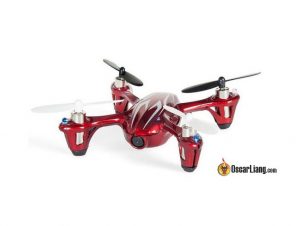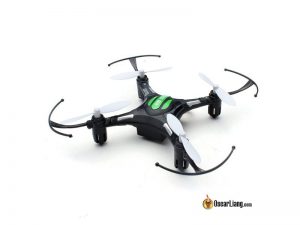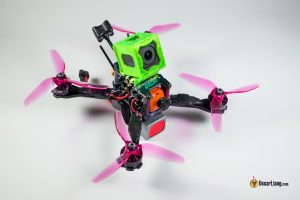FPV (First-Person View) drones and Gimbal drones are two distinct types of unmanned aerial vehicles (UAVs) designed for different purposes and use cases. Here are the key differences between FPV drones and gimbal drones.
In this article we will discuss the different types of radio controlled drones that you can buy or build to get into the hobby. These drones are also known as quadcopters, multirotors or multicopters, which are basically just RC helicopters with multiple motors. These are radio controlled (RC) model aircraft designed for racing, aerial photography or just purely for fun.
Did you know that there are many different configurations of multirotor as well?
Table of Contents
Toy Drones
Toy drones are widely available and cost as low as $20. They are very small and usually no bigger than the size of your palm. They are very light weight and robust against crashes, however they tend to have low power and speed compared to other drones in this list.
These Toy grade quadcopters are also called “Micro brushed quads” because they use brushed (coreless) motors.
Summary
- Price Range: $20-$200
- Weight: Less than 50g
- Size of your palm
- Suitable for indoor flying
- Great for beginners
Check out this guide to learn about how pick your first toy drone and start out flying.
Basic Micro Quadcopter
They are great for complete beginners to learn the basics of controlling a drone using radio transmitters sticks, and they can take quite a bit of beating. There are hundreds of different toy quadcopters available from well known brands such as Hubsan, Eachine, Syma and Cheerson.
Some of these micro brushed quadcopters might come with a low quality camera that usually has no use in my opinion. Resolution is so low it’s impossible to take any good video or photos, and they normally cannot be used for FPV (live stream video). As a rule of thumb, just don’t expect anything below $200 to have any kind of good recording cameras.
Examples
- Eachine H8 and E010
- Hubsan X4
The Hubsan X4 has been around for years and it remains to be one of the most recommended micro drone for beginners.
More recently the Blade Inductrix and E010 became some of the most popular micro quadcopters in the hobby, for both new comers as well as experienced pilots. They are very tiny and the propellers are well protected by ducts, you can bump into anything and not damage the props. They became so popular due to the unlimited upgrade potential, where you can add FPV gear and turn them into fun indoor FPV quads.
FPV Micro Quads
These FPV micro quads are more advanced and equipped with FPV setups. They utilize proper radio transmitter (such as the Taranis or Spektrum) and FPV Goggles that you would normally use with a full size mini quad.
Recommendation
Cheap FPV Quadcopter Options For Learning
You can build your own multicopter and setting up your FPV system. But if you don’t have the electrical knowledge or skills, there are also other cheap ‘plug and play’ FPV quadcopter options available. One famous example would be the Hubsan H107D FPV Mini Quadcopter.
This is a complete FPV system, the LCD screen and video receiver are built into the radio transmitter. It’s a relatively cheap way to get you into FPV flying, and a pretty good training platform for beginners.
FPV Drones
FPV drones are designed for speed, maneuverability, and durability, offering an immersive flight experience that is increasingly popular in various applications. Pilots, equipped with goggles that provide a live video feed from an onboard camera, experience the thrill of seeing exactly what the drone sees in real-time. This first-person view (FPV) demands a certain level of skill and practice for effective navigation.
These drones have gained significant traction among filmmakers and clients seeking adrenaline-fueled creativity and the ability to place cameras in previously risky or inaccessible locations. FPV technology is revolutionizing the filmmaking industry, offering directors unprecedented flexibility in camera placement.
However, flying FPV drones requires a higher level of piloting skill due to the unique first-person perspective and the absence of a third-person visual of the drone. Beginners may initially find controlling an FPV drone challenging, but with practice, these skills can be rapidly acquired. This should not be a deterrent; the learning curve, while steep, is surmountable and rewarding.
One of the standout features of FPV drones is their high customizability. Enthusiasts and professionals alike can modify and upgrade numerous components, including frames, motors, propellers, and cameras. This adaptability allows us to meet the specific needs of our clients. For instance, we can equip drones with live streaming units for real-time broadcasting, or modify them for waterproofing in extreme environments. Ultimately, FPV drones provide the flexibility and creative freedom necessary to realize a client’s vision and exceed their expectations.
Unlike the simplicity of a toy grade quadcopters, the construction of an FPV drone could be a bit more complicated. Racing drones are equipped with on-board camera to allow the pilot to see what the drone sees in first person view (FPV).
Summary
- Price Range: $300 to $600 or more
- Weighs 400g – 600g in average for 200mm wheelbase racing quads
Custom Built FPV Drones
Majority of the hobby racing drones are self-built. For people unfamiliar with electronics the learning curve can be a little steep, but many found building their own quadcopters is just as fun as flying. You get to choose whatever parts you want, install and configure the software, and finally tune it to fly the way you like.
Bind and Fly (Prebuilt BNF)
If you don’t like building and keep things simple, you can also just buy a RTF (ready to fly) quadcopter, saving the the troubles for DIY.
Popular Choices
- Eachine Wizard
- TBS Vendetta
- ImmersionRC Vortex Pro
- TBS QQ190
Different Racing Drone Sizes
There are many different sizes for a racing drone, which is determined by the size of the propellers.
TLTR: 5” is the most popular for both beginners and professional pilots. They are relatively easy to build and have enough power to lift an HD camera. Components for 5″ racing drones also are the most widely and cheaply available compared to other drone of different sizes.
2″, 3″ and 4″ – Typically very small and suitable for indoor as well as outdoor on a calm day. They are the perfect option for tight spaces and park flying without causing too much noise.
5″ and 6″ – The most common size for drone racing and freestyle flying. They are the most versatile due to the fact they offer a large amount of power yet have incredible maneuverability and are able to carry a HD camera such as a GoPro without a significant compromise on flight characteristics.
7″ or bigger – People looking for long range and better efficiency mostly choose larger rigs. These offer even more power and space to carry extra hardware and bigger battery in the cost of agility.
Camera Drones
Camera drones are predominantly utilized for filming and aerial photography, delivering high-resolution, professional-grade footage from the skies. These drones typically come pre-built and are often more expensive than hobby-grade quadcopters. They boast high-end cameras, GPS navigation, and advanced technological features, making them a top choice for professional aerial videography and photography.
In terms of user accessibility, camera drones are particularly beginner-friendly. Thanks to their third-person perspective and advanced camera stabilization systems, they offer an easier learning curve for controlling the drone and capturing stable, high-quality footage, even for those with limited piloting experience.
DJI stands as the industry leader in this segment, with a reputation for innovative, high-quality camera drones. Other notable brands in this space include 3DR, GoPro, Xiaomi, Walkera, among others, each bringing unique offerings to the world of aerial imaging. Learn more about DJI drone offering here: https://oscarliang.com/dji-drones/
Summary
- Price Range: $500 – $2000 or more
- Weight: 1Kg-1.5Kg in average
- Size: 300mm to 400mm diagonally in average
Edit History
- Mar 2017 – Article created
- Jun 2018 – Article revised













2 comments
This Information was great and for a RAW Novice like myself and needing all the help I can get it makes things a bit clearer,
Thank You.
i’m thinking of making my own aerial photography drone as my Level 3 Engineering, which products and parts would be reccommended to use. I might be putting my own FPV camera on it as well and would like to know which brands would be best to use